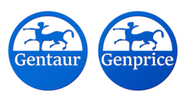Description
Mouse Cdk14 Antibody | 60-536 | Gentaur UK, US & Europe Distribution
Host: Rabbit
Reactivity: Human, Mouse
Homology: N/A
Immunogen: This Mouse Cdk14 antibody is generated from rabbits immunized with a KLH conjugated synthetic peptide between 45-72 amino acids from the N-terminal region of mouse Cdk14.
Research Area: Cell Cycle, Neuroscience
Tested Application: WB
Application: For WB starting dilution is: 1:1000
Specificiy: N/A
Positive Control 1: N/A
Positive Control 2: N/A
Positive Control 3: N/A
Positive Control 4: N/A
Positive Control 5: N/A
Positive Control 6: N/A
Molecular Weight: 53 kDa
Validation: N/A
Isoform: N/A
Purification: This antibody is purified through a protein A column, followed by peptide affinity purification.
Clonality: Polyclonal
Clone: N/A
Isotype: Rabbit Ig
Conjugate: Unconjugated
Physical State: Liquid
Buffer: Supplied in PBS with 0.09% (W/V) sodium azide.
Concentration: batch dependent
Storage Condition: Store at 4˚C for three months and -20˚C, stable for up to one year. As with all antibodies care should be taken to avoid repeated freeze thaw cycles. Antibodies should not be exposed to prolonged high temperatures.
Alternate Name: Cyclin-dependent kinase 14, Cell division protein kinase 14, Serine/threonine-protein kinase PFTAIRE-1, Cdk14, Kiaa0834, Pftk1
User Note: Optimal dilutions for each application to be determined by the researcher.
BACKGROUND: Serine/threonine-protein kinase involved in the control of the eukaryotic cell cycle, whose activity is controlled by an associated cyclin. Acts as a cell-cycle regulator of Wnt signaling pathway during G2/M phase by mediating the phosphorylation of LRP6 at 'Ser-1490', leading to the activation of the Wnt signaling pathway. Acts as a regulator of cell cycle progression and cell proliferation via its interaction with CCDN3. Phosphorylates RB1 in vitro, however the relevance of such result remains to be confirmed in vivo. May also play a role in meiosis, neuron differentiation and may indirectly act as a negative regulator of insulin-responsive glucose transport (By similarity) .


![Mouse Cdk14 Antibody (N-term) [AMM06423G] Mouse Cdk14 Antibody (N-term) [AMM06423G]](https://cdn11.bigcommerce.com/s-1rdwiq712m/images/stencil/590x590/products/57218/57522/gentaur-genprice__26005.1661610467__29809.1661628092__75433.1661676199__77988.1661684280__64362.1661692443__72927.1661853812.png?c=1)







